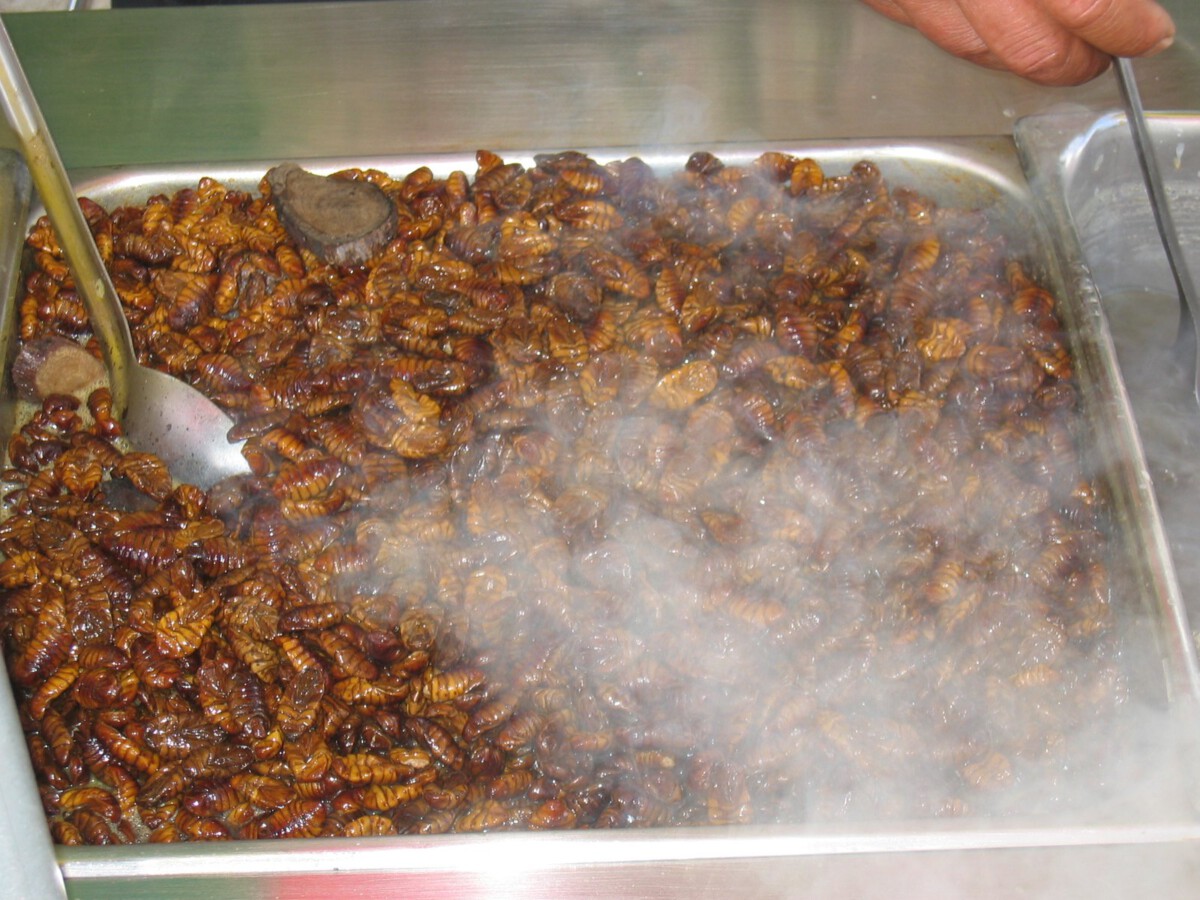Silkworms: A Crunchy, Nutritious Bite

Wandering through the bustling street markets of China, it’s impossible to miss the sizzling aroma of grilled silkworms. Skewered and roasted over open flames, these tiny larvae are served hot and seasoned, offering a protein-packed snack that is both surprising and sustainable. Many locals see silkworms as a smart food option because they are rich in protein and essential amino acids, while requiring far less land and water than traditional livestock—an eco-friendly choice backed by the Food and Agriculture Organization. The chewy texture and nutty flavor are not for everyone, but adventurous eaters claim the taste is unforgettable. Street vendors, especially in cities like Beijing and Chengdu, display trays of wriggling silkworms, enticing passersby with their novelty. For tourists, trying silkworms has become a rite of passage, a bold story to share. As awareness of sustainable eating grows, silkworms are gaining new fans among the health-conscious crowd in China.
Starfish: An Edible Ocean Oddity

Starfish are not just beautiful creatures of the sea—they’re also an unexpected delicacy in Chinese coastal cities. Vendors skillfully grill or deep-fry starfish, then serve them with spicy or savory sauces, drawing curious crowds. The flesh inside is chewy, with a flavor that reminds some of crab or sea urchin. Starfish are surprisingly nutritious, containing omega-3 fatty acids that support heart health, according to the Chinese Academy of Sciences. Eating starfish may seem shocking, but it reflects a broader trend in China toward consuming lesser-known marine invertebrates as people seek out new tastes and health benefits. The experience of cracking open a starfish and scooping out the meat is both hands-on and memorable, making it a popular snack for adventurous foodies. With rising demand for unique seafood, vendors in places like Qingdao and Dalian now feature starfish regularly on their menus. The sight of a spiky starfish on a stick is sure to stop tourists in their tracks.
Scorpions: Danger Turned Delicacy

Few street foods evoke as much shock and awe as skewered, fried scorpions. In night markets across Beijing, rows of live scorpions wriggle on sticks before being plunged into bubbling oil. The end result is a crunchy, salty snack that’s both thrilling and surprisingly tasty. Eating scorpions is not just about the dare—it’s rooted in Chinese tradition, often appearing at festivals and celebrations. Nutritionally, scorpions offer a lean source of protein and are low in fat, making them a guilt-free treat for the brave. According to a survey by the China Food Industry Association, younger generations are especially drawn to insect snacks like scorpions, seeking novelty and a break from the ordinary. Vendors often sprinkle the fried scorpions with chili powder for added kick, making each bite an explosion of flavor. For many, conquering a scorpion is the ultimate travel trophy, forever remembered in photos and stories.
Fried Grasshoppers: The Eco-Friendly Crunch

Grasshoppers might make you think of summer fields, but in China, they’re a beloved street snack. Vendors fry them until they’re golden and crisp, tossing them with spices for a savory punch. Grasshoppers are loaded with protein, fiber, and vitamins—so much so that the United Nations has recognized them as a sustainable food source. They need far less water and feed compared to cattle or pigs, making them an eco-friendly alternative for the future. In cities like Kunming and Guangzhou, fried grasshoppers are sold by the bagful, with locals munching them much like popcorn. The taste is nutty, sometimes compared to toasted sunflower seeds, while the texture is satisfyingly crunchy. With the edible insect trend catching on, more Chinese consumers are embracing grasshoppers for their health and environmental benefits. Eating a handful might seem wild at first, but the delicious crunch quickly wins over skeptics.
Stinky Tofu: The King of Funky Flavors

Stinky tofu is one of China’s most famous—and polarizing—street foods. Its powerful, pungent aroma can be detected from blocks away, deterring some but attracting devoted fans. Vendors deep-fry the fermented tofu, then serve it with spicy sauces or pickled vegetables, transforming it into a crispy, flavorful treat. The fermentation process gives stinky tofu its complex umami taste, which many enthusiasts describe as addictive and deeply satisfying. According to the Chinese Culinary Association, stinky tofu consistently ranks as one of the country’s most popular street foods, especially in southern regions like Hunan and Guangdong. It’s not just about the taste; eating stinky tofu is a cultural experience, often shared with friends and family at night markets. The dish’s growing popularity is a testament to China’s love for bold, adventurous flavors. Those who try it once often return for more, claiming that nothing else compares.
Century Eggs: A Timeless Chinese Treat

Century eggs, also known as preserved or “thousand-year” eggs, are a staple in Chinese cuisine with a look that can surprise first-timers. Made by preserving duck, chicken, or quail eggs in a mix of clay, ash, and quicklime, the eggs turn dark green or black with a creamy, flavorful yolk. Despite their unusual appearance, century eggs are packed with nutrients and have high antioxidant content, as reported in the Journal of Food Science. They’re often sliced and served with pickled ginger or added to congee and salads. Locals cherish them for their rich, savory flavor and velvety texture. For many visitors, the experience is both shocking and fascinating—how can something that looks so odd taste so good? The tradition of eating century eggs dates back hundreds of years, and they remain a beloved part of China’s food culture today.
Grilled Snake: A Bite of the Wild

Grilled snake is a street food that challenges even the most adventurous eaters. Vendors marinate various types of snake meat in aromatic spices, then grill it over open flames, filling the air with a smoky aroma. The meat is surprisingly tender, often compared to chicken, with a subtle, slightly gamey flavor. In southern China, snake is believed to have medicinal qualities—locals say it can boost vitality and ward off illness. The China National Food Industry Association notes that snake consumption is on the rise, especially in provinces like Guangdong and Guangxi, where it’s considered a delicacy. Eating grilled snake is about more than just flavor; it’s an encounter with ancient culinary traditions and a taste of the wild side. The sight of snake skewers sizzling on the grill draws crowds of curious onlookers, some daring enough to give it a try.
Deep-Fried Tarantulas: A Fearless Feast

Deep-fried tarantulas are as much about the thrill as the taste. In some regions of China, these large, hairy spiders are seasoned and fried until crispy, then served as a crunchy snack. The idea of eating a tarantula might terrify some, but for daredevils, it’s an irresistible challenge. The International Journal of Food Sciences and Nutrition reports a growing interest in edible arachnids, with people drawn to their high protein content and novelty factor. Tarantulas have a mild, earthy flavor—some say they taste like crab or shellfish. Vendors often display them alongside other exotic snacks, luring in tourists eager for a wild food adventure. For many, biting into a tarantula is a once-in-a-lifetime experience, equal parts shocking and exhilarating.
Chicken Feet: Collagen-Packed Street Snack

Chicken feet, known as “phoenix claws,” are a beloved staple in Chinese street food and dim sum culture. Vendors braise the feet in rich sauces, infusing them with flavor and making the texture pleasantly tender. Chicken feet are a source of collagen, which is prized for its benefits to skin and joint health. According to the China National Culinary Association, chicken feet rank among the top street foods nationwide, reflecting their deep cultural roots. Eating chicken feet can be tricky at first—there’s a knack to nibbling around the bones—but the reward is a savory, gelatinous treat. Locals often enjoy them with friends over tea or beer, making it as much a social ritual as a snack. The popularity of chicken feet continues to grow, thanks in part to their reputation as a beauty food.
Bubble Tea: A Sweet Street Sensation

Bubble tea, or “boba,” might not sound outrageous, but its explosive popularity has made it an icon of modern Chinese street food. This sweet drink mixes tea, milk, and chewy tapioca pearls, often customized with fruit flavors, jellies, or even cheese foam. Bubble tea shops line the streets of every major city in China, and the drink has spread worldwide. Market research shows that the global bubble tea market could hit $3 billion by 2025, reflecting its status as a cultural phenomenon. Young people in China have embraced bubble tea as more than just a drink—it’s a lifestyle, a fashion statement, and a daily treat. The endless combinations and playful textures make it fun and addictive. Bubble tea’s rise from humble origins to global craze is a testament to China’s creativity and evolving taste.






